|
|
|
|||
|
|
||||
|
|
||||
| Smoke Trails | ||||
|
|
HOME | SITE MAP | FORUM | CONTACT |
|
||
|
ABOUT | MOTORS | MODELS | ARCHIVE | HISTORY | STORE | FAQ | LINKS
|
|
|
|
|
|
||||||||||||||||||||||||||||||||||||||||||||||||||||||||||||||||||||||||||||||||||||||||||||||||||||||||||||
|
Smoke Trails 7
(December 2006)
by Roger Simmonds (Initial publication: SAM 35 Speaks, December 2006) Reactionary Reflections All things considered, it hasn’t been too a bad year for us rocketeers, with plenty of jet action at the SAM Gala and elsewhere. Because of problems to be discussed later, I was down to my last model, the Skyleada Hunter, which was flying splendidly, if unpredictably, with Rapiers of varied thrust and duration, until it attacked Andy Blackwell’s Thermos flask in a particularly low-flying sortie. Peterborough Flying Aces was all but impossible this year due to uncharacteristic gales, but Old Warden the following week (to which I couldn’t go) was blessed with marvellous weather. Andy Blackwell’s Draken went particularly well, and Mike Stuart again demonstrated what a splendid fliers his new Fiat G.91 and L-3 powered Saab Tunnan are. Gratifyingly, we have, throughout the year, seen several newcomers, who had taken advantage of the recent improved availability of old and new kits. I hope they will not be deterred by the current troubles with Rapiers. |
|
||||||||||||||||||||||||||||||||||||||||||||||||||||||||||||||||||||||||||||||||||||||||||||||||||||||||||||
|
As Funf has alluded to, the chronic problem this year has been ‘exploding’ Rapiers, or, rather, Rapiers whose thrust is over-spec (thus the unexpected though sometimes spectacular aerobatics of otherwise predictable models like my Hunter) or, more calamitously still, whose cases burn through, leading to, at the very least, a scorched model, at worst, a write-off. We did have hopes at the beginning of the year that the supply situation and reliability of Rapiers would improve after Dr Zigmund’s retooling, during which he changed his casings, and secured a new source of propellant (widely rumoured to come from defunct Soviet rockets!). Alas, the hoped for improvements have not been seen. Quite the reverse in fact. Some batches behaved, er, well, I was going to say, ‘as it says on the tin’, but Dr Z has, perhaps wisely, or ominously, stopped putting the specifications on his boxes. Other batches have shown variable thrusts, still others an unacceptable failure rate of 25%. There have also been problems with the new fuses, which appear to burn with less ferocity than the old ones, and ignition failures have been common. Perhaps it is a deliberate ploy by Dr Z to prevent his motors failing. Understandably, all this could inhibit our enthusiasm! Now some modellers, like Mike Stuart, (who must be protected by angels) have had few problems, but others, having seen their prototypes immolating after a only a couple of flights, have decided to wait before flying again, or putting knife to balsa, or computer mouse to CAD program to generate that exciting new plan. I must confess that I am in this latter group. I am unwilling to condemn my newly restored models to a fiery, if authentic, apotheosis, and until we have clear evidence that Dr Z has improved his quality control, or we have an alternative source of motors, I will be flying profile models and build something large for my Jetex PAA-Loader. |
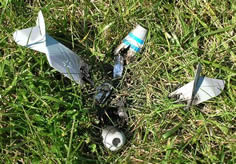
- Marty Richey
|
||||||||||||||||||||||||||||||||||||||||||||||||||||||||||||||||||||||||||||||||||||||||||||||||||||||||||||
|
|
|
||||
|
Old motors can also be unreliable, of course, but I don’t anticipate any difficulties with the PAA-Loader, which was one of the more straightforward ones – easier to use than the 50 – and I have ample supply of fuel and some good wick. Other modellers, pursuing the righteous path of authentic (or non-exploding) motors, have had problems. John Miller Crawford, keeper of the Sanctum Sanctorum of Jetex.org in New Zealand, acquired a boxed example of an early 50, complete with fuel, wick, washers and gauzes, to power his (Replikit) Keil Kraft Panther (right). The wick in particular looked dubious – it was flaky – and John obtained some better stuff from Edward Jones. The asbestos washers had a curious green patina, but John had no spares for these, so the mould was scraped off before the motor was assembled and loaded in the time-honoured way. And so to the flying field, there to attempt the first Jetex flight in New Zealand for many, many years. The Panther glided straight and true, a credit to Hatfull’s design and John’s building, so the fuse was lit, and, most gratifyingly, the 50-year old pellet ignited first go. After waiting for 3-4 seconds, the model was launched … but, disappointingly, only into an extended glide. A repeat launch showed that the thrust was indeed very low. Now Andy Blackwell, backed up by Alex Hutchison, maintains that pellets do not go ‘off’, and thinks the degraded washers allowed leakage around the end cap (not easy to see, says Andy). He has now sent John some better examples so that the keenly anticipated NZ Jetex revival can continue. |
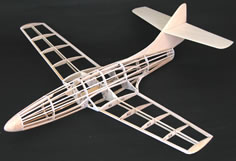
- John Miller Crawford
|
||||
|
Apart from the necessity to use undamaged washers of the right size (they did vary from subcontractor to subcontractor) and the correct gauzes, shields and the like (ditto), there is at least one another pitfall for the unwary when using Jetex motors. Do not, under any circumstances, use Sebel fuel, which burns a lot hotter than even ‘Red Spot’ fuel in the Wilmot Mansour aluminium-bodied motors. To demonstrate the dangers, Andy loaded one of his less pristine Jetmasters with a Sebel (post 1958) formulation, lit the fuse and stood well back. The result is shown on the right. Nasty. So do take care: the 50C and PAA-Loader, which have steel cases, can take any pellet, but the aluminium alloy motors (apart from the Atom 35) should only be used with genuine ICI pellets. Old motors do need care and experimentation to get working properly; so, unless, like Andy, you have a vast collection of useful spares, it is perhaps best to keep your valued antiques for display only. It could be argued that for even greater authenticity, John should have fitted the New Zealand equivalent of the Jetex 50, the Velojet Junior 50 (right), in his Panther. Despite assiduous searches, however, he has been unable to find a single example. Actually, comparatively little is known about Velojets, which were last featured (briefly) in the (Jet)X Files, December 2004. Since then, I found that New Zealander John Reid had written about them in one of Roger Wathen’s legendary Pssst Off Sheets (Vol. 2 No 10). This edited extract is reprinted with his permission: “Ivan Harrington produced some 3000 motors in the mid 1950s. They were about the same size as a Jetex 50, but there were some differences. The end cap screwed on, requiring no gaskets. Protection against bursting was achieved by a spring-loaded safety valve at the front of the casing, cleverly integrated in the mounting. To ignite the fuel [pay attention here, this is practically unbelievable] one simply lit the pellet and screwed on the end cap. This is not quite as tricky as it sounds because the fuel burns very slowly before the pressure builds up inside the casing. There is a knack to it though!“ John goes on to say that after one had mastered the art (and retained one’s fingers more or less intact), it seemed a lot easier than messing about with wicks, gauzes and washers. I’ll take his word for it! John continues, “After Ivan retired in 1980 he made a new batch of 300 or so. Unfortunately, he was not able to enforce his own high quality standards so motors from this batch have to be treated with caution. I had an end cap blow off, which did not make for a humorous occurrence”. If any reader has any information about the Velojet, for example what were the pellets made of, and more about its modus operandi (and that of its larger stablemate), I would like to hear from you. New Jetex motors could also be of variable quality, as a number of subcontractors were used over the years; nor was the availability of motors, fuel, or wick, at least in the late fifties and early sixties, always what it should have been. In fact, I hardly saw a Jetex kit at this time – I think the local model shop had by that time lost interest in the genre. Supplies of the genuine article across the Empire were even more uncertain, leading to local entrepreneurs offering alternatives. We see an analogous situation today, and it is possible to purchase, on eBay, a number of ‘Jetex-like’ motors, that, unlike the Velojet, are produced with no expertise or quality control at all. If you are tempted by any of these pathetic products from the amateurs’ lathe, which are fit only to be used as expensive paperweights, then the following story of an ersatz ‘Jetex’ motor may deter you. This also first appeared in a Pssst Off Sheet (Vol. 6 No 34). Steve Hickman, who was 11 at the time, lived in Karachi. His time there, he says, remains a shining memory as a high point in his flying model experience. Steve writes: |
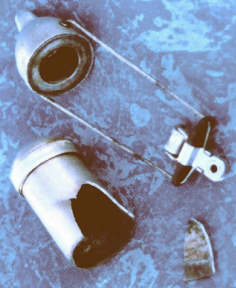
- Andy Blackwell
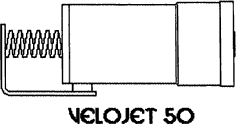
- Andy Blackwell
|
||||
|
“I acquired a British Jetex-powered plane, the kind where you slip the wing and stabilizer into a profile-type fuselage. It was painted an aluminium colour, with maybe some markings [sounds like the Sharky (right), which came with a Jetex 50]. I will never forget the beautiful flights I had with that plane. The kit must have been perfectly trimmed – it climbed in a spiral during the power phase and glided back in a straight line, a truly glorious experience. I had little trouble with the fuse clogging the exhaust nozzle [didn’t we all] but compared to experiences with rubber powered planes and unstartable glo-plug engines, this really was ‘life in the future’. Eventually the fuel ran out, and, being an optimistic kid, I looked around Karachi, which was still very British. But Pakistan wasn’t the really the place to find Jetex fuel. What I did find, eventually, was a Pakistani copy of the very plane I was flying. It was made of thicker wood, but the outlines were the same, as was the silver colour, and even the box was identical to the British kit. The only real difference was in the ‘Jetex’ motor. The nozzle was at least 3/16" diameter, and the fuel pellets were a mustard colour. This latter gave me pause, because that was the colour of the explosive substance in Pakistani firecrackers, for which, by that time, I had a healthy respect! So when it was time to light the fuse of this bootleg Jetex I was on the alert, but thought that at least I wasn’t going to have any problems with the fuse clogging the exhaust nozzle. I remember what happened next in terms of sound effects – a wheezy ‘puuhh’ as the propellant lit with a cloud of mustard smoke, and a dull clunk as the plane hit the ground nine feet away. My brother, who had a perverse sense of humour, remained looking upwards, pretending to search the skies for it.” This is a nice story, and a testimony to the excellence of the original Wilmot Mansour ARTFs. I haven’t yet seen a Jetex Sharky in the air, though Howard Metcalfe, I know, has at least one. Given its reported performance with a Jetex 50, it should go very well with a low rated (100-110 mN) L-2. These, by the way, seem more reliable than the higher powered ones. |
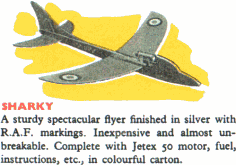
- Wilmot Mansour brochure c. 1954
|
||||
|
Cougars I know of only one Cougar kit for Jetex power. Given the popularity of the Panther as a scale subject, it is a little disappointing that its more formidable successor was all but neglected, despite being a lot shapelier and having swept wings that provide enough lateral stability without the Panther’s excessive dihedral. Telasco didn’t spare the hyperbole in their 1959 advertisement on the right, but then this 28" span 30” long model, designed by Paul Del Gatto, is a prestigious, if not meretricious, product. I wonder how many they produced, or made and flown successfully. The Spacemaster (the US Jetex 350 equivalent) must have been difficult to get at that time; but, even so, the Scorpion, (Del Gatto’s favourite motor) is a somewhat odd choice for a scale model, where a lower thrust over a longer period is surely to be preferred. I haven’t been able to find a plan for this kit, for which extensive prefabrication is claimed, so I don’t know if the construction is similar to a Jetex ‘Tailored’ model. It would need to be much reduced and modified for Rapier power anyway. Though I’m sure Steve Bage would take in his stride, it would be easier to modify Hatfull’s design with new wings and stabiliser if one wanted a ‘vintage’ model for Rapier power. However, there is no real need to do this; a very nice plan was drawn up some years ago by US modeller Andy Ray. This is a fine design for L-2 that deserves to be much better known (below). Please ask if you would like a copy of the plan. |
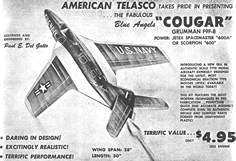
- Model Airplane News, Jan. 1959

- Howard Metcalfe
|
||||
‘Rocket-Propelled Model Aircraft’ by D. H. G. Ince |

- photographs by Andy Ray
|
||||
|
The above article, which was published in ABA News Vol. 2 No 5, Jan. 26, 1947, was kindly passed to me by our editor. ABA News was the ‘Official organ of the Association of British Modellers’, an organisation that has been discussed in the pages of SAM 35 Speaks. We are not told who D H G Ince is (was he well-known?). His article covers only one page, there is no plan, and only a very poor photo of a ‘flying test bed’, as he calls it, which I have done my best to render publishable. But the article is historically interesting as (a) it predates Jetex, (b) Mr Ince reports his experiments with Brocks R.P.3 units, which at least shows they were commercially available, however briefly, (c) his observations are actually quite sensible. The R.P.3 motors, you will remember, were developed by Howard Boys, and produced a thrust of around 2 - 3 oz for 13 sec. (see Smoky Addiction No 6). The introduction is worth quoting at some length, “In view of the increasing interest shown in this aspect of model aircraft building and flying, I feel readers [does anyone know the circulation figures of ABA News?] will be interested in a series of experiments carried out during the past year. The model in question has a ‘knock off’ tailplane, booms and nacelle, and is practically crash proof […] as a means of getting familiar with rocket propulsion it is a layout that can be thoroughly recommended […] flights of 75-80 seconds from a tow launch have been the maximum achieved”. Mr Ince then has the following points to make: “Design – stick to strong, simple and stable designs. Motor Mounting – never mount your rocket in a metal tube.It was manufactured in a cardboard tube for reasons of safety, so don’t turn it into a potential hand grenade! [frustrated Rapier flyers take note]. Thrust Line – Models are very susceptible to changes in its angle to the datum line. As with pushers, 7 to ten degrees of downthrust is a good practical figure […] the underslung position seems to suggest itself. Take off – ‘Light it and leave it and save it’.[?] This means ROG or a ten second fuse with a fast tow launch – it can be done.” All this is good stuff. Mr Ince seems to have been quite impressed with Brock’s rockets, and, at the very least, he appears to have had a lot of fun. I wonder if he published anything about Jetex. The layout of his model is quite prescient, and similar to, for example, Dick Struhl’s Jiffy Jet of 1951 (below). This too is a very strong all-sheet model that should be quite up to a towline launch and resistant to exploding Rapiers! |
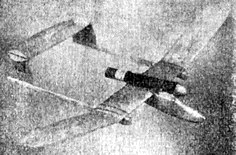
- ABA News Vol. 2 No 5, Jan. 26, 1947
|
||||
 Amongst models currently on the market, the all balsa twin boom Zephyr (right) from the Australian company bears more than a passing resemblance to Struhl’s Jiffy Jet, and could also claim Ince’s rocket model as a progenitor. Rocket Reminiscences |
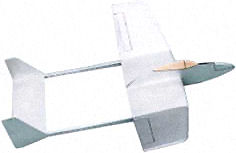
- Peter Lloyd
|
||||
|
Both John Park and I were attracted to the recently published Dangerous Book for Boys (right), which, according to the publisher’s blurb, shows the boys of today what their forefathers got up to and how their thrilling activities could be emulated. Alas, it is rather a disappointment, and the manuscript had obviously been done over by the H & S E and corporate lawyers until it became sufficiently anodyne and inoffensive. There is precious little in it about guns, knives, explosives, rockets, or even model aircraft. The most dangerous thing about the book is the possibility of a paper cut. A great shame, and how far it is off the mark of what we really got up to is shown by this nice story of John’s, which is taken from his Of Clouds And Rainy Weather, reminiscences of a boy’s life in the 1950s. “I had known all about multi-stage rockets since Christmas 1954, when I had as a present a splendid book called Rockets, Jets, Guided Missiles and Space Ships [right], by Jack Coggins and Fletcher Pratt. Coggins was a good illustrator and the book contained any number of really excellent atmospheric watercolours that I would have loved to have emulated. Not long after reading the book, I got the idea that a step-rocket – as they were called then – could be made by taking the stars out of a sixpenny rocket, leaving the top open and gluing a rolled paper tube to the side of the casing opposite the stick to accept the stick of a fourpenny rocket with the touch-paper removed. The idea was that, at the end of the flight, the forward blast of the bigger rocket that normally ignited and ejected the stars would ignite the smaller rocket and allow it to climb still higher. It was then, as now, quite illegal to modify fireworks; but I didn’t know that, and even if I had I wouldn’t have been deterred from putting my idea into practice. I tried it, and it worked. As a general rule, the second stage ignited immediately while it was still moving upwards under the thrust of the first stage, and it would streak away at great speed to a really impressive height, where the single small star it carried was a speck in the sky. In due course, I took to equipping the second stage with a paper nose cone containing the stars from the first-stage rocket. Sometimes I left the stars out altogether and glued a banger, fuse end down, into the open top of the second stage. I don't think I ever had a failure with this simple system, though sometimes the second stage would be a little slow igniting and would head off at an angle instead of straight up. |
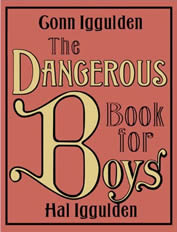  |
||||
|
“The real fun came a couple of years later, when Keith and I decided to dispense with sticks and use fins instead. As an aeromodeller, I was well aware that fins are ineffective at low speeds, but I hoped that the rocket's initial acceleration would be sufficiently fierce. I tried a single-stage version first, and it worked perfectly, so Keith and I collaborated on a beautiful red-and-silver two-stage effort with a bursting charge, as my book called it – a tuppenny banger [right] in other words – in the nose of the second stage. This was fired from the back garden at No. 25 one Saturday afternoon. As it shot away, almost straight up, Keith and I were awed by our success. In this, we were a little premature: the second stage was unusually slow to ignite, and when it did, the whole thing was pointing straight down again. With gravity helping rather than hindering, the acceleration of the second stage, banger and all, was simply terrific and it had become a blur long before it hit the ground. The ground it hit was actually the soft earth between Ern Newman's rows of cabbages, barely twenty feet from the launching point, and considerable penetration was achieved before the bursting charge did its stuff. A very fine smoking crater was the result, and we were highly delighted. Sadly, Ern was not. There was some unpleasantness, which might have been a good deal worse if my father hadn't been as amused by the affair as he so obviously was. He clearly disapproved of Ern's attitude, and I received only a token scolding which in no way turned me off further experiments. All it did was make me conduct them away from home. |
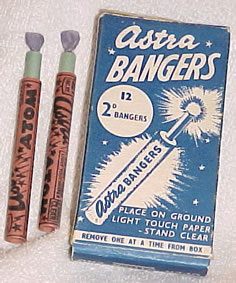 |
||||
|
“The best two-stage design I came up with used two sixpenny rockets. The upper stage, complete with stars or a bursting charge, had three short conventional rocket sticks glued to it, accurately spaced at 120° intervals round the diameter. These extended below the base of the rocket for about one-and-a-half times the length of the case, and each had a balsa fin glued to its outer surface in such a way that it could stand upright for launching. The lower-stage rocket, its bare case open at the top, was slid up inside the three sticks to act as a ‘booster’ stage: the friction that held it in place against the base of the upper rocket had to be carefully adjusted by sandpapering the inside faces of the sticks, so that the blast of second-stage ignition (how good that phrase sounded!) would easily blow it clear and allow it to fall away. The design worked, too. I think I made several, but the only launch I remember was after dark, on the cricket pitch up by the castle. There was a cast-iron drain cover that made an ideal launching pad, and I remember the great height the second stage reached after an almost perfect separation. Its trajectory was a little off the vertical, but that was no bad thing because it gave us a really good view of the flight.” Thank you, John. This is indeed authentically dangerous stuff. It is quite uncanny how closely my own (slightly later) rocket experiments were analogous to John’s, except, being much influenced by Project Mercury at the time, I launched capsules containing hapless woodlice that (usually) parachuted to earth. Hmm … perhaps it’s time to publish my own ‘Jetex Jim’s Jolly Japes’. But who would pay for all the litigation? |
 |
||||
|
|
|||||
|
|
|
||||
|
|
|
|
|
|
|
|
Acknowledgements - Article: Roger Simmonds - Illustrations: Roger Simmonds, Andy Blackwell, John Miller Crawford, MAAC archives via Bill Henderson, Peter Lloyd, Howard Metcalfe, Andy Ray, Marty Richey, JackCoggins.info, FireworkMuseum.co.uk |
|
|
|
|
ABOUT | MOTORS | MODELS | ARCHIVE | HISTORY | STORE | FAQ | LINKS |
|
|
Terms of Use
|
Queries? Corrections? Additions?
Please
contact us.
|
|